
 The newsletter of NASA's Radio JOVE Project
The newsletter of NASA's Radio JOVE Project"Solar and Planetary Radio Astronomy for Schools"

 The newsletter of NASA's Radio JOVE Project
The newsletter of NASA's Radio JOVE Project

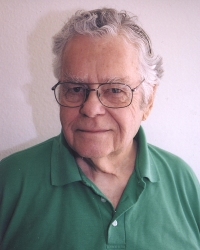
Astronomer, writer, educator, and co-discoverer of Jupiter's radio emissions, Ken Franklin passed away on June 18, 2007. Ken Franklin began his career in 1954 as a research fellow at the Department of Terrestrial Magnetism of the Carnegie Institution (DTM/CIW) in Washington, D.C. In 1955, Ken and Bernard Burke, at the time a staff member of the DTM/CIW, discovered that the planet Jupiter was a strong source of radio emissions. This discovery marked the birth of the field of planetary radio astronomy.
In 1956, Ken joined the staff of the American Museum-Hayden Planetarium as Assistant Astronomer. Ken was Chairman of the Hayden Planetarium and Department of Astronomy of the American Museum of Natural History from 1972 to 1974. From 1956 to the time of his retirement as Astronomer at the end of 1985, Ken's duties included presenting, and often writing, innumerable sky shows for the planetarium sky theater, teaching popular and technical courses in astronomy several times each year, and answering questions from the public. During the first moon landing in 1969, Ken was an on-camera astronomy expert for the NBC coverage of the event, appearing with Frank Magee.
Ken taught at several east coast universities and colleges, he was the Astronomy Editor of the World Almanac from 1970 to 1995, and, from 1980 to 1992 provided all of the astronomical calculations for the Farmers Almanac. Ken contributed daily almanac information to the New York Times from 1975 to 1997. As a columnist from 1983 to 1997, Ken originated and wrote the weekly "Skywatch" feature that appeared in the science section of the New York Times.
Asteroid Number 2845 is named FRANKLINKEN in his honor.
Since his retirement, Ken had been an astronomical lecturer in several national parks and for Lindblad Travel, Society Expeditions, American Hawaii Cruises (Tahiti), and for the Discovery Tours program of the American Museum of Natural History.
Since 2004, Ken and his wife, Charlotte, have resided in Loveland, Colorado. Ken is survived by his wife, Charlotte, and his daughters Kathleen Williams, Christine Redding, and Julie Jones.
Read NY Times Obituary for Dr. Franklin.
The galactic background is experienced through the Jove receiver as a background hissing noise that varies slowly in amplitude over 24 hours. This radio noise is produced by electrons spiraling in the Milky Way's magnetic field. It gets stronger in the direction of the galactic plane and is especially strong toward the galactic center. The Jove receiver is capable of detecting the small change in signal strength between the plane of the Milky Way, as it runs through the galactic center, and the rest of the sky.
SETTING UP THE JOVE RECIEVER
To detect the Milky Way, use a single or twin Jove dipole, the Jove Receiver, and a computer running Radio SkyPipe. Set up the Jove system as usual, with the dipole(s) running east-west. If you are in extreme northern or southern latitudes you may want to use the phasing cable to tilt the beam of the antenna in the direction of the constellation Sagittarius. The Jove receiver gain should be set between the 12 and 3 o'clock positions and the software volume control set so that the baseline trace falls between 1000 and 2000 on SkyPipe. The following SkyPipe setup is suggested for a 24 hour Milky Way scan.
SKYPIPE SETTINGS FOR A 24 HOUR GALACTIC SCAN
STEP 1 Change the samples of data per second.
This reduces the samples of data to one per second and minimize the space needed to store your scan. A higher sample rate will not allow you to share your data file on the Radio Jove archive because of the file size.
Click OPTIONS on the SkyPipe tool bar.
Select the STRIPCHART tab.
Set Sample Period ms to 1000.
Click SAVE and DONE.
STEP 2 Set the data logging time for a 24 hour scan.
Click OPTIONS on the SkyPipe tool bar.
Select the LOGGING tab.
Check the box marked "Start New Run"
Set Max Duration to 24:00 and be sure that Max Samples reads 1000000000 by default.
The Max Duration setting, in conjunction with the sample rate in step 1, will cause SkyPipe to save and restart the chart before the default max sample is reached.
Uncheck the box marked "Restart Chart at".
Click SAVE and DONE.
PLANNING YOUR OBSERVATION
Once these settings are implemented you are ready to begin. Plan your observing day by choosing an hour to begin and making sure you can safely leave the system on for 24 hours. It is not a good idea to make a Milky Way scan if there is thunderstorm activity predicted to occur within the observation period. If you intend to repeat your Milky Way scan over the course of a year be sure to choose the same time to begin every observation. This gives you a standard by which you can trace the motion of the Milky Way as the earth revolves around the sun. Remember also to take into account the switch between daylight and standard time if necessary.
AFTER YOUR OBSERVATION
After SkyPipe has completed its 24 hour chart of the background it is time to look at your data. First begin by loading the saved data file and clicking the "show the entire file on a single screen" button. This button should be on the lower left of the view screen control buttons. It has four small arrows facing outward in four different directions. To see the "hump" in your chart data you will have to adjust the Y axis by clicking the arrow button that decreases the Y axis span. On SkyPipe this button has two vertically oriented arrows facing in toward each other. This exaggerates the Y axis data and allows the barely perceptible Milky Way hump to be seen clearly. One of the first things you notice is the striking difference between day and night on the scan. (figure 1) During night hours the baseline is very smooth with very few spikes of interference. During daylight hours the baseline is full of spikes from distant lightning and man-made interference.
OTHER USES FOR GALACTIC SCANS
Galactic background scans are also useful in detecting Jupiter and solar x-ray bursts. Strong Jupiter emissions will show up as spikes on the relatively smooth background during night hours. (figure 1) During the day solar x-ray bursts can ionize the ionosphere more than usual and cause it to absorb the Milky Way's radio emission.(figure 2) We call this phenomenon Sudden Ionospheric Disturbances or SID. These show up as sudden dips in the chart during daylight hours.
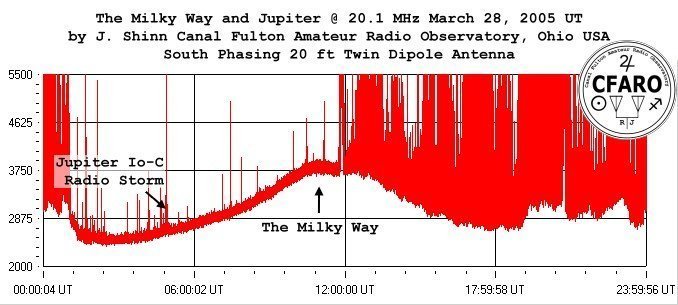
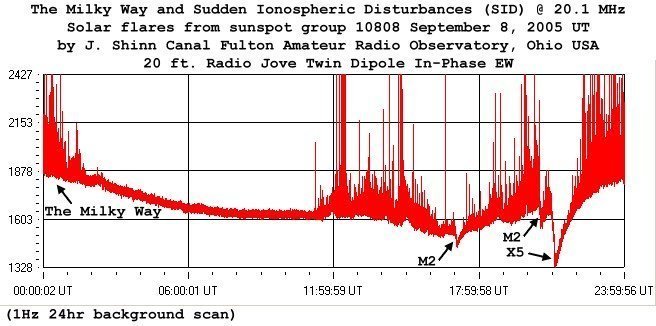
Editor's note: Maxim Usatov and Nik Korchewski of the Ukraine have also been doing some great work observing Galactic transits. Check out their webpage which includes photos of their equipment and plots http://www.bcsatellite.net/bao/VSR/gplane.html
The radio observatory project of the Preparatory National School no. 5 of the Universidad Nacional Autonoma De Mexico (UNAM), was created four years ago through the initiative of students and professors and after much study and hard work.
We have two Radio Jove systems, one here in the facilities of our preparatory school no. 5 and another one in the preparatory no. 1 south of Mexico City. We also have three satellite dishes of 3, 5 and 6 meter diameter respectively, two Yagi antennas (9 meter length that operates at 110 MHz and another 12 meters that operates at 20.1 MHz.). These systems are used for observing and tracking Jupiter and Io.
This project began with the objective to attract more young people to science, to enable them to see it from another point of view, to make science less abstract. They learn the importance of setting goals and of having patience. They may not be successful at first but with patience they can always try again.
We have been able to promote science to a very special sector of the community, the children between 4 and 6 years of age; to try to instill basic astronomy, and do it in a way that is educational and fun.
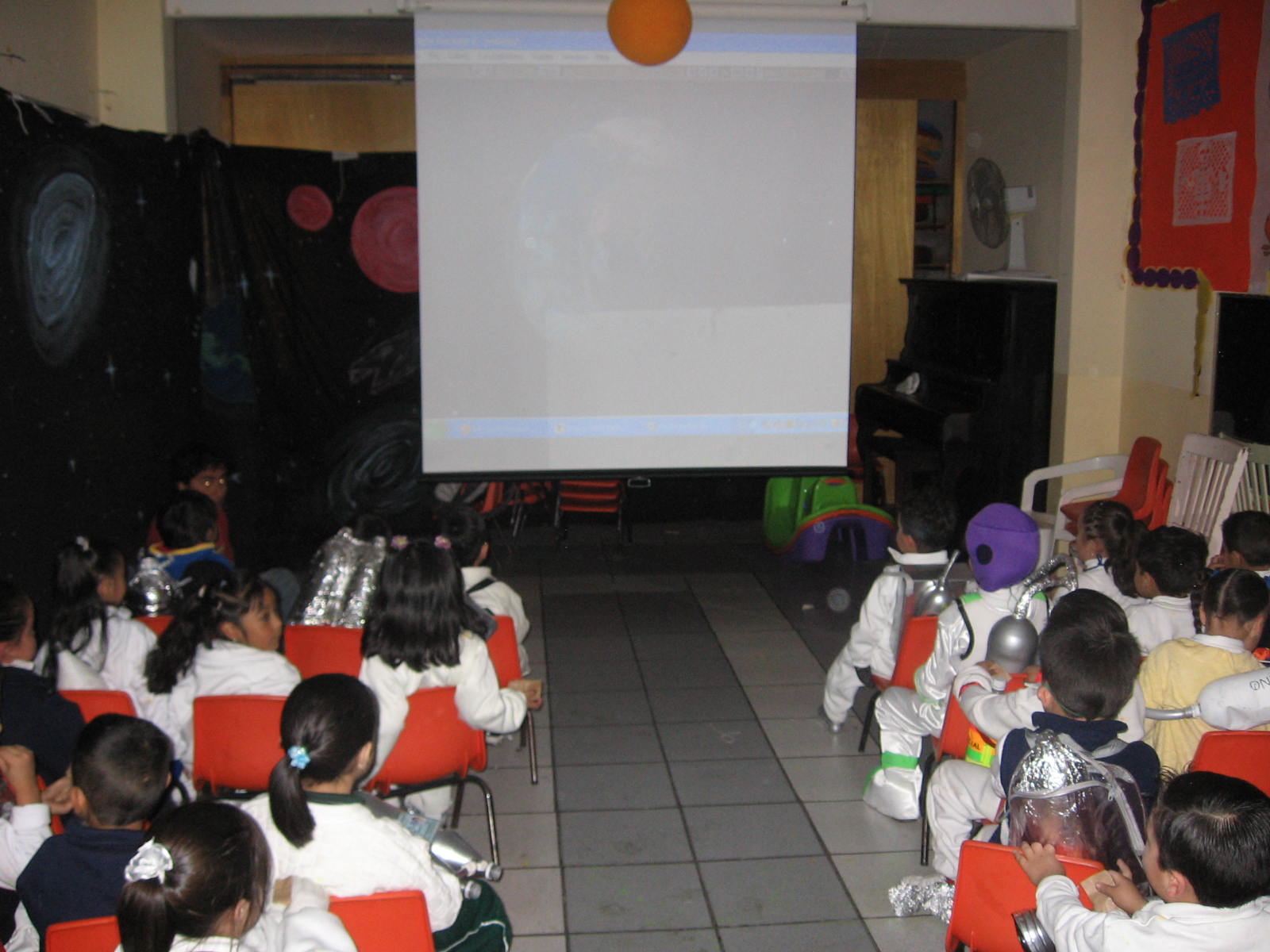
The program is multidisciplinary, dealing with mathematics, physics, astronomy, geography, computer science, English and electronics. One of the advantages of working as a team is, if one does not know such-and-such matter the other knows it, therefore the work proceeds and the students can then appreciate the value of teamwork. After many of us learned electronics and with the aid of antennas, receivers, computers, spectrum analyzers, software (including Radio SkyPipe and Starry Night) and much patience, on January 23rd we detected a solar explosion which was corroborated by several observatories at NASA.

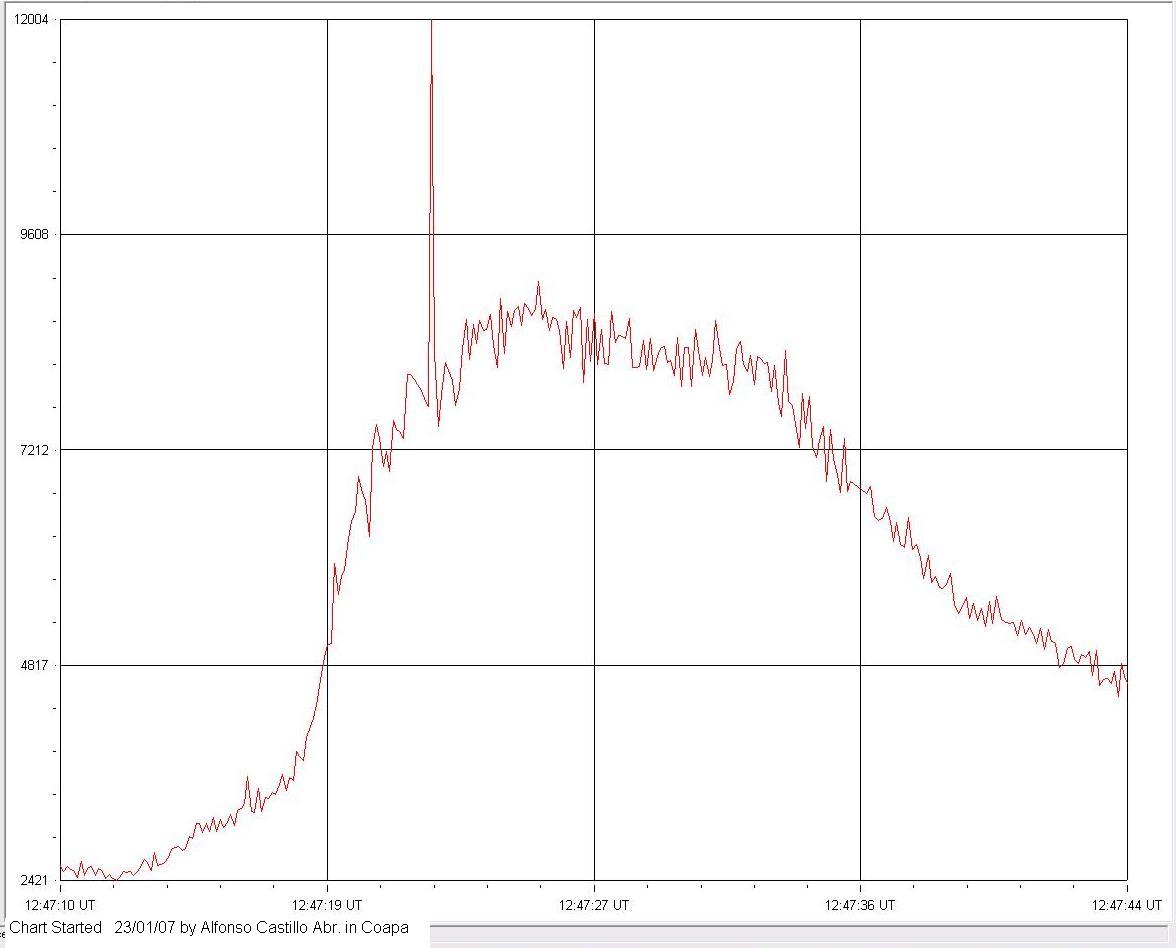
This was a great event for our preparatory school as well as for our university. Approximately 150 students made up the Radio Jove project team. Their ages range from between 15 to 19 years old. We also had 12 professors of physics and mathematics participate. We are very happy to have participated in this radio astronomy project.
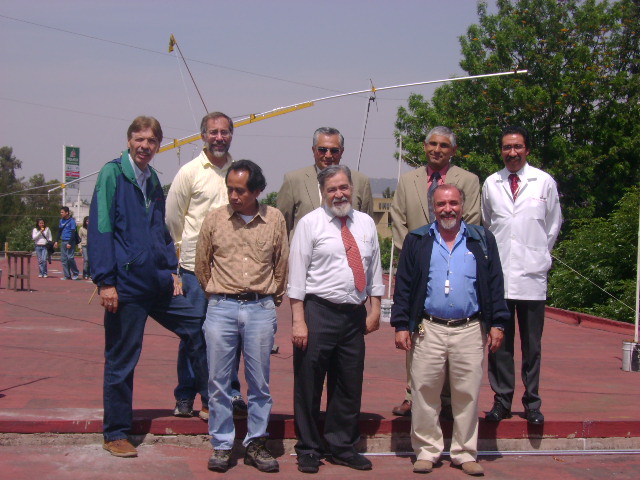

So far, with the exception of a few storms, this has been a pretty quiet year for Jupiter. Last year wasn't much better. I recall that back in 2000 Jupiter storms were more frequent, and pretty darned strong - even with our relatively small Jove dual dipole antenna.
One of the biggest factors controlling emission probability is De - the Jovicentric declination of the Earth. The following plot (from Radio Jupiter Pro) shows that back in 2000 De was near its maximum positive value (+3.5 degrees) and that during 2006 and early 2007 it was near its maximum negative value (-3.5 degrees).
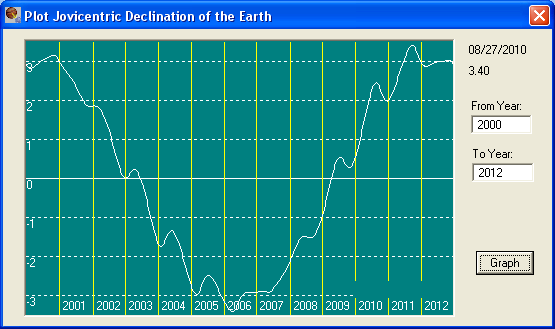
Years of study at the University of Florida and other research facilities have shown that Jovian emission probability closely follows De, being highest when De is most positive.
So now the good news. Take a look at the plot. In mid 2007 De starts its climb away minimum. For the next several years De will only be getting more positive - and with the increasing values of De we can expect more frequent and stronger Jupiter storms.
A few times each year all the conditions seem right for a really great Jupiter storm. Sometimes it happens - sometimes it doesn't. The May 21, 2007 Radio Jupiter Pro, Io/CML plot predicted a track directly thru the IoA region with activity running from 0440 to 0746UTC. Jupiter would pass thru the center of the antenna beam for US east coast stations around 0600 UTC (0100 EDT). The stage was set.
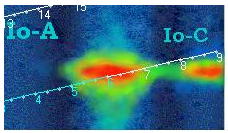
Many of the usual suspects (Tom Ashcraft, Wes Greenman, Jim Sky, and Dick Flagg) were logged onto the UFRO radio spectrograph and also to SkyPipe data sources. Wes had set up the spectrograph frequency range and polarization via remote access.
As we gathered around our network connection the storm began. The following spectrogram and SkyPipe records give some idea of the complexity, strength, and beauty of this storm.
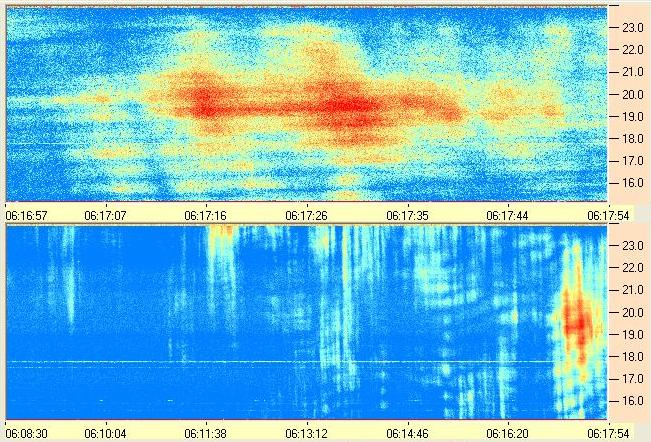
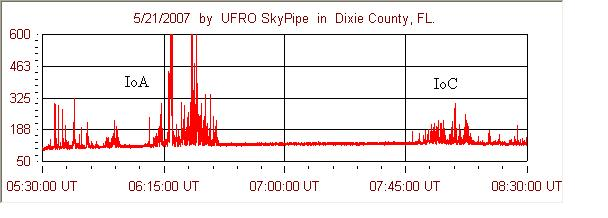
While the SkyPipe record shows activity at 20 MHz (with a long pause between IoA and IoC), there was almost always activity at some frequency between 15 and 24 MHz as observed on the spectrograph. L-bursts dominated, although there were times when both L- and S-bursts appeared simultaneously, just at different frequencies. Modulation lanes, horizontal bands and shadowy arcs cut thru the emission regions. The storm went on for over 3 hours, causing more than one late-night observer to beg for Jupiter to be quiet, so we could go to bed.
I hope we were not the only Jove Team members to monitor this great storm. For all you newcomers - remember it takes patience and persistence but the rewards are worth it.
If you haven't already done so, visit the Jove website and download SkyPipe, Radio Jupiter Pro, and the Spectrograph viewing software. Join us online for the next great Jupiter storm.
Both WCCRO and UFRO have been operating radio spectrographs for several years now. These instruments routinely serve spectrograph images over the internet. The spectrographs rely on a mix of old and new technology - using a microprocessor controlled oscillator to step thru 200 channels 10 times each second. The oscillator is part of a classic superheterodyne receiver which drives a logarithmic detector and a low speed analog to digital converter.
Recently I had the opportunity to try out a fascinating instrument - the RF Space SDR-14,which uses a high speed analog to digital converter (66 MHz) preceded by a preamplifier and low pass filter.
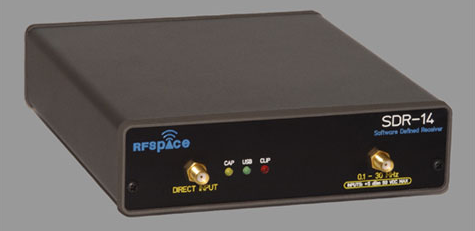
All you do is hook the box up to your antenna, connect the output to your computer via a USB cable and stand back. Thanks to its FFT (fast Fourier transform) capabilities the SDR-14 will generate and display a spectrum several MHz wide with several thousand point frequency resolution. Not only is this thing powerful, but it's tiny - about 6 inches on a side and less than 2 inches high.
Wes Greenman and I took the SDR-14, along with his laptop out to the UFRO radio observatory one night in March hoping to snag some S-bursts during an Io-B storm. Francisco Reyes and Chuck Higgins were also there running a special experiment to look at S-bursts in very high detail.
The SDR-14 was hooked up to the UFRO TP array (a wideband, high gain, antenna comprising 8 right-hand and 8 left-hand log-spiral antennas). Wes had been playing with the software (Spectravue) and was pretty good at navigating thru the feature-rich selection of parameters. The storm yielded a few minutes of S-bursts which displayed quite nicely. A few weeks later Wes drove out one foggy night and caught a very nice Io-A storm. The L-burst activity was complete with modulation lanes - drifting diagonal bands first discovered by Jorma Riihimaa over 40 years ago. The following image shows a couple of minutes of that activity - extending from 19 to 22 MHz. Time runs horizontally with frequency as the vertical axis. Signal strength is depicted by different colors.
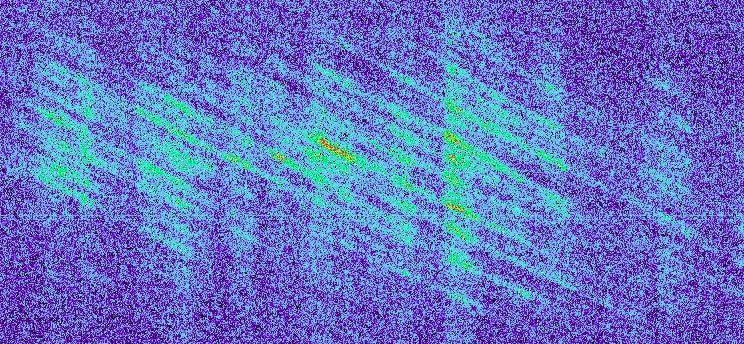
We tried the SDR-14 on Wes' Jove dual-dipole antenna during the daytime. Unfortunately at the time he was plagued with power line buzz. Although the dual dipole is not designed as a wide band antenna, it should perform well enough over a few MHz of bandwidth for Jupiter, and certainly for solar bursts. You will find additional information about the SDR-14 at http://www.rfspace.com
Editor's Note: These are some photos sent to us by Mr. Vivek Jamble of his Radio Jove system in India. Thank you!



The JOVE Bulletin is published twice a year. It is a free service of the Radio JOVE Project. We hope you will find it of value. Back issues are available on the Radio JOVE Project Web site, http://radiojove.gsfc.nasa.gov/
For assistance or information send inquiries to:
or
